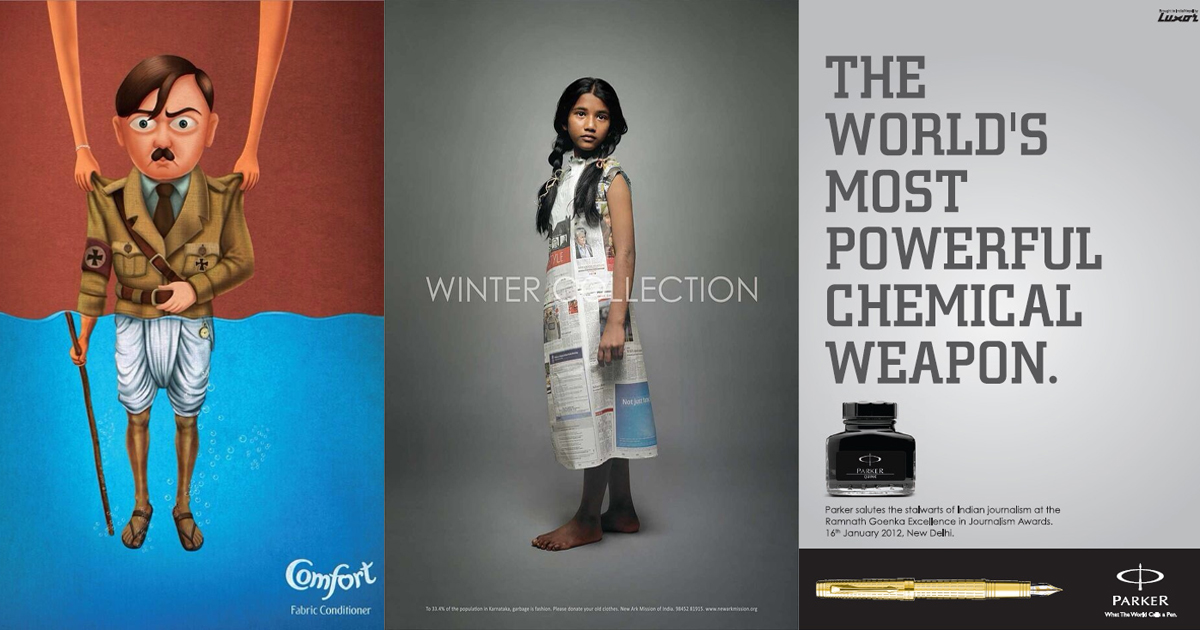
It wasn't just a joke. In the late 1950s, it was a major event in the television industry. This was during which the Golden Age was full swing and the most powerful broadcast networks were making huge profits from sponsored programs. Not to mention that they were making their own commercials.
The first TV commercial that used color was actually an advertisement for the first liquor company to advertise on television. In fact, there were actually two of them. One of these ads appears in the Guinness Book of World Records.
The advent of color television set was not possible until the mid-1960s. Advertisers could choose which programs to promote and purchase a block of time. This was a change from the past. They could have their commercials seen millions of times. There were however some limitations. NBC, for example, had the only live color camera, while only a few stations had the color equipment.

The most ridiculous thing of all: RCA produced the first TV commercial in color. Although it was a re-make of the old standby, it still managed to get the attention of its audiences. A television capable of showing up to a million colours was quite a feat back then. Major networks were making a lot and it seemed like the best way for them to be remembered was to showcase the latest technologies.
Although the ad ran for only 10 seconds it was still the longest color TV spot ever. The production cost of the ad was much lower than it is today. It's therefore not surprising that the product was so popular.
The first commercial in color television was also aired on Philadelphia's Color Television channel. This was a series of slides that was actually an advertisement, which was a technological breakthrough for broadcast media.
The first real color television set, which was made in color, was installed in a Columbus, Ohio, home the same year the ad. It was then that the state's first Wendy's burger restaurant opened. McDonald's also ran an important advertisement called "Piano Recital". These advertisements, along with the Coors Light ads "At the Silver Bullet", "At the sexy hour" were very popular. These ads became so popular that the companies that made them were forced to produce their own versions. Some companies even remade the ads to better meet their needs.

The first TV commercial in color was not the end-all and be all of television. It was an important milestone in the history TV, and the public was just a few years away. Ultimately, it was a boon to advertisers, as the new color technology allowed them to be creative in their campaigns.
FAQ
How much does it cost for social media advertising?
Social media advertising is expensive if you choose to take this route. You'll be charged monthly according to how long you spend on each platform.
Facebook: $0.10 per 1,000 impressions
Twitter - $0.20 Per 1,000 Impressions (if you tweet).
Linkedin - $0.30 for 1,000 impressions if your send out invitations
Instagram - $0.50 per 1,000 impressions.
Snapchat - $0.60 per 1,000 impressions ($0.40/user)
YouTube - $0.25 per 1,000 views
Tumblr – $0.15 per 1000 impressions for text postings
Pinterest - $0.05 per 1,000 impressions per month
Google + $0.15-$0.20 for 1,000,000 impressions
Tumblr - $0.15- $0.20 per 100,000 impressions
Vimeo - $0.20-$0.25 per 10,000 impressions
Soundcloud - $0.20-$0.25 per 1 million plays
StumbleUpon - $0.20 -$0.25 per 1 billion pageviews
Digg - $0.20 to $0.25 per 1000 diggs
Reddit - $0.20 - $0.0.25 per 1000 Comments
Wordpress $0.20-$0.25 per 500 Comments
Flickr - $0.20 -- $0.25 per 5,000 photo uploads
What do you need to know about print advertising?
Print advertising can be a powerful medium for communicating with customers. Many companies use print advertising to promote their products. The main goal is to catch the attention and buy from the consumer.
Print ads are typically one page long and include text, images, logos and other graphics. These ads may include sound, animation and video as well as hyperlinks.
Here are the main types and classifications of print advertising:
1. Brochures – These are large format printed pieces that are intended to draw people into stores. Brochures are filled with eye-catching designs, colorful pictures, and attractive graphics.
2. Catalogues – These are smaller versions to brochures. These are often sent to customers who have asked for information on particular items.
3. Flyers - These are small pieces of paper distributed at events such as concerts and fairs. They are generally free but must be paid for if they are handed out at retail outlets.
4. Posters – These are larger versions for flyers. They are displayed on walls, fences, and buildings. They are usually created using computer software programs designed to catch passersby's attention.
5. Direct mail – This is a direct mailing of letters or postcards directly to customers. These cards are sent by companies periodically to remind their customers about their company.
6. Newspaper Ads – These are ads that appear in newspapers or magazines. These ads are often quite long and include both text and images.
What is branding?
Your brand is your way of communicating who you are as well as what you stand behind. It is how people remember your name.
Branding is about creating a unique identity that distinguishes your company. Branding is more than a logo. It encompasses everything, from the physical appearance of your company to the voice and tone used by your employees.
A strong brand makes customers feel more confident about buying from you. And it gives them confidence in choosing your products over those of competitors.
Apple is a prime example of a company with a strong brand. Apple is a globally recognized brand because of its beautiful design, high-quality product lines, and friendly customer service.
Apple's name is synonymous with technology. Apple is the brand people think of whenever they see a smartphone or computer.
If you're considering starting a new business, you should consider developing a brand before launching. This will give your business a face and personality.
What is an ad campaign?
A campaign is a series advertising messages that are designed to promote a product. It can also refer to the whole production of such ads.
The Latin word for selling is "ad." Marcus Terentius Varro (116–27 BC), the first known user of the term "ad" used it to mean "to make sales."
Advertising campaigns are often carried out by large agencies or companies. Many media types can be used in these campaigns, including television, radio and print.
Advertising campaigns typically last for several months and have specific goals. One example is that some campaigns seek to create awareness while others are more focused on increasing sales.
What do you need to know about internet advertising?
Internet advertising is an integral part of any business strategy. It allows businesses to reach potential clients at a low price. There are many types of internet advertising. Some are free while others may require payment.
There are several options for advertising on the internet. These include banner ads, pop-up advertisements, search engine optimization (SEO), PPC (pay-per-click) advertisements, social media and mobile marketing. Each method has its advantages and disadvantages.
What is affiliate market?
Affiliate marketing is an online model that allows you to earn commissions for referring customers to other websites. If someone buys from your product, you get paid by the owner.
Affiliate marketing relies on referrals. You don't have to do anything special for people to buy from you. You just need to refer them to our website.
Making money doesn't require any hard selling. It's equally easy to sell and buy.
You can even set up an affiliate account in minutes.
Referring more people will result in more commission.
There are two types affiliates.
-
Affiliates who own their websites
-
Affiliates who work with companies that provide products and/or services.
What do you need to know about television advertising?
Television advertising is a powerful medium to reach many people at one time. It was also very costly. But if you use it correctly, it can be extremely powerful.
There are many different types of TV ads, but they all have certain common characteristics. The first thing to remember when planning any type of TV ad is to ensure it fits into its category. You shouldn't attempt to make a lifestyle commercial the same as a product ad. Your message must be consistent throughout the campaign.
Remember that prime-time is the best time for your ads to be aired. This is because the majority of viewers will watch TV while they relax in front a set. They should be able to concentrate on what you are saying.
The bottom line is that even if you have a lot to spend, it doesn't necessarily mean you'll be able to get great results. In fact, the opposite may be true. The University of California conducted a study that found commercials shown on popular programs were less likely than those on non-popular programs to sell products. Make sure you are doing it right if you're spending a lot on TV advertising.
Statistics
- Advertising's projected distribution for 2017 was 40.4% on TV, 33.3% on digital, 9% on newspapers, 6.9% on magazines, 5.8% outdoor, and 4.3% on radio. (en.wikipedia.org)
- Worldwide spending on advertising in 2015 amounted to an estimated US$529.43 billion. (en.wikipedia.org)
- It collects money from the advertisers, keeps 32% for its role in facilitating the process, and the remaining 68% goes to the publisher (you). (quicksprout.com)
- Google will display whichever ad type (CPM or CPC) is expected to earn more revenue for the publisher, which is in Google's best interest since they take a 32% share of the revenue. (quicksprout.com)
External Links
How To
How can I advertise through Google?
AdWords can be used by businesses to advertise using keywords that they are interested in. Set up your account first. The first step is to choose a campaign title, budget, ad type (text/image, video), and keywords. You then place your bids on these keywords. Clicking on an advertisement will only result in you being paid if the click is from someone who searched one of your targeted keyword phrases. You can get paid even though people don’t buy any products.
Google has many tools to help you ensure your ads work. These tools include Ads Preferences Manager Manager and Keyword Planner. These will allow you to identify the best options for your company.
A keyword planner can help you identify the right keywords for your campaigns. You can also see how competitive certain keywords are, which will help you decide whether to spend money bidding for them.
Ads Preferences Manager can be used to adjust settings such as the maximum impressions per hour and the minimum price per click.
Analytics allows you monitor and compare the performance to your ads against other companies. You can view reports that show how your ads performed in comparison to other ads.